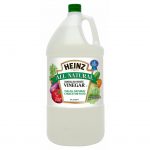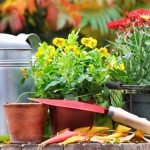by Ken Lain, the mountain gardener
Seasoned gardeners seem to have their favorite super-secret homemade garden gadget or brew that “can’t be topped” for controlling pests, fertilizing flowers, or extracting maximum value from their landscapes. However, as these tricks-of-the-trade get passed from one homeowner to the next, sometimes the effectiveness and purpose of the first cure get lost in translation. For example: Use beer to attract and drown slugs and snails? Sure. Leave out dishes of beer to make browsing rabbits tipsy? Not.
The next time you’re faced with a plant problem and don’t want to make a trip to the garden center for a selective spray, granule, or gadget, consider one of these four DIY solutions.
Newspapers – If there’s a reason not to go completely digital, the flower garden is it. Start  collecting those newspapers, because a thick layer of newsprint can go a long way towards controlling weeds. Layer a stack of papers one to two inches thick over garden soil and cover with an ornamental mulch. Even if a few weeds do germinate, they will be very easy to yank out, even a few years after the newspaper was laid on the flowerbed.
collecting those newspapers, because a thick layer of newsprint can go a long way towards controlling weeds. Layer a stack of papers one to two inches thick over garden soil and cover with an ornamental mulch. Even if a few weeds do germinate, they will be very easy to yank out, even a few years after the newspaper was laid on the flowerbed.
Newspaper #2 – Use a layer of newspapers at the bottom of flower containers to keep water from rushing out of the drainage holes. This is especially useful in terracotta pots which tend to keep their planting compound on the dry side anyway because they’re so porous.
Newspaper #3 – While shredded newspaper is an excellent addition to the compost bin, you can see faster results when using it in the worm compost bin. Run newspaper through a paper shredder to get the most uniform bedding, and then add enough water to get the moisture you would find in a wrung-out sponge. Place this in a lidded plastic tub with a few holes for aeration, and add some kitchen scraps for food. Your red wiggler worms will thank you with a ready supply of earthworm castings to feed your favorite bedding plants and flowering houseplants.
Citrus Peels – Instead of wasting beer in the trap for slugs, set out citrus peel halves to attract the unwanted gastropods. Slugs gather and stick themselves to the underside of the peel taking shelter and using the moisture. Collect the skins in the morning, and throw them away. One of the best attributes of the peel method is that it’s rainproof: who wants to deal with overflowing beer dishes and their soggy corpses?
unwanted gastropods. Slugs gather and stick themselves to the underside of the peel taking shelter and using the moisture. Collect the skins in the morning, and throw them away. One of the best attributes of the peel method is that it’s rainproof: who wants to deal with overflowing beer dishes and their soggy corpses?
Citrus Idea #2 -Instead of composting your citrus peels use the halves as plantable seed-starting pots. Cut a slit in the bottom of the citrus peel halves, fill with seed starting soil, and plant one or two seeds in each citrus “starter pot”. Plant the peel directly into the ground when the seedlings reach transplant size. Score the bottom of the skin to help fine roots reach your garden soil more quickly. Citrus pots also decompose faster than peat pots, they’re more economical, and they provide nutrients to the ground that help plants get a healthy start. If you aren’t a big citrus consumer, save them over time in the freezer.
Soda Bottles cut in half – Even when cold temperatures don’t threaten, a soda bottle cloche can  help get flower transplants off to a safe start. When you sow seeds outdoors, the newly emerging seedlings are most vulnerable to predators until they develop a few sets of true leaves. Nocturnal cutworms and hungry birds are just two pests that will consume unprotected seedlings. Keep seedlings covered with soda bottle halves (caps removed) until they’re well established and large enough to resist pests.
help get flower transplants off to a safe start. When you sow seeds outdoors, the newly emerging seedlings are most vulnerable to predators until they develop a few sets of true leaves. Nocturnal cutworms and hungry birds are just two pests that will consume unprotected seedlings. Keep seedlings covered with soda bottle halves (caps removed) until they’re well established and large enough to resist pests.
Soda bottles #2 – Soda bottles can make extensive hanging gardens possible for even the smallest spaces. Nailing rows of soda bottle halves across a discarded wood pallet yields an instant, and inexpensive, chic wall garden. Depending on spacing, you can fit up to 60 planters in rows on a pallet. Increase the ornamental appeal of soda bottle plant hanger with imaginative crafty additions. For instance, create macrame hangers for a small grouping of hanging bottles. Choose rainbow hues of yarn or rope to complement your flowers. Try painting your bottles with a spray paint formulated for plastic. If you aren’t feeling crafty, don’t worry about decorating the bottles; choose trailing flowers like lobelia, million bells, and chenille plant to camouflage the bottles.
Vinegar – Housekeeping gurus have long extolled the virtues of vinegar as a cleaning agent, but  this acidic pantry staple has flower garden applications as well. Number one is the use of vinegar as an herbicide. Protect your established garden plants that you don’t want to injure by over-spraying with strong solutions. Spray the vinegar directly on young weeds, and expect to repeat weekly for tough weeds. If you really need to break out the big guns for poison sumac, foxtail, and horehound, you can purchase Bonide Burnout horticultural vinegar here at Watters Garden Center. This effective product has an acidity of 20%.
this acidic pantry staple has flower garden applications as well. Number one is the use of vinegar as an herbicide. Protect your established garden plants that you don’t want to injure by over-spraying with strong solutions. Spray the vinegar directly on young weeds, and expect to repeat weekly for tough weeds. If you really need to break out the big guns for poison sumac, foxtail, and horehound, you can purchase Bonide Burnout horticultural vinegar here at Watters Garden Center. This effective product has an acidity of 20%.
Vinegar #2 – Take advantage of vinegar’s cleaning ability for your flower containers and garden tools. Mineral deposits on terracotta pots are especially annoying but dissolve easily after a soak in a half vinegar-half water mix. Rusty tools also take on a new shine after a soak in distilled white vinegar.
Giant Pumpkin Harvest November 3 @ 11am

Ever wonder what’s inside a GIANT pumpkin? There are rumors of super slim, double thick walls and thousands upon thousands of seeds inside. The second largest pumpkin in the state of Arizona is on display here at Watters Garden Center. On November 3rd at 11:00 a.m. we will slice and dice this big boy to discover its Contents of Horrors! Every attendee receives one of the seeds, and the rest will be grown for next spring’s garden customers to plant. Join us and be part of the fun!
Gardening Classes
November 3 @ 9:30 a.m. Fall ‘To-do‘ List for a Healthy Yard 
Get the most out of your landscape with an easy-to-use checklist of fall care. Bring color to autumn gardens, reduce bugs next spring, or just put your landscape to bed with simple-to-follow ideas.
FB.com Live – If you can’t attend this class, watch the Livestream on Facebook. Like our Page to be notified when we go Live.
After November 3rd our Saturday Garden Classes will be on hiatus until early winter. Check our Website for the Class Schedule where it will be posted once we have finalized the dates and topics.
Until next week, I’ll be here at Watters Garden Center helping local gardeners infuse their landscapes with abundant fall colors and stunning winter evergreens.
Ken Lain can be found throughout the week at Watters Garden Center, 1815 W. Iron Springs Rd in Prescott, or contacted through his web site at WattersGardenCenter.com or FB.com/WattersGardenCenter .

